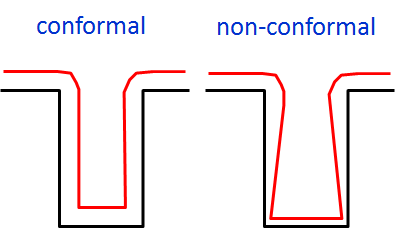(1) deposition 공정이란?
<WHAT>
웨이퍼 위에 원하는 분자 또는 원자 단위의 물질을 박막의 형태로 형성하는 공정.
<WHY>
목표하는 특성을 갖게 하기 위해서.
ex) isolation(trench filling), gate stack(gate oxide, electrode), via/contact, ILD/IMD oxide, metal lines
(2) requirements for desirable deposition
- quality: desired composition, low contaminants, good electrical and mechanical properties.
ex) electrical properties: resistivity, dielectric characteristic, breakdown voltage, …
mechanical properties: residual stress, adhesion, yield strength, … - unifomity: within wafer, wafer to wafer.
- step coverage: conformal coverage on non-planar topography.
- filling: good filling of space and line pattern.


(3) deposition 공정의 종류
- PVD (physical vapor deposition): 물리적 기상 증착 (화학적 반응을 동반하지 않는다).
- CVD (chemical vapor deposition): 화학적 기상 증착 (화학적 반응을 동반).
* vapor deposition: 증기, 가스 형태로 박막을 만드는 것.
| PVD | CVD | |
| 방식 | 물리적인 힘에 의한 증착 | 화학적 반응에 의한 증착 |
| uniformity | 나쁨 | 좋음 |
| 두께 control 유리 | 나쁨 | 좋음( ∵gas의 양 조절로 쉽게 조절 가능) |
| 공정온도 | 저온(좋음) | 고온 |
| 불순물 오염 | 낮음(좋음) | 있음( ∵화학반응 부산물) |
| 적용 | 금속박막 | 절연막, 금속, silicon |
<참고문헌>
이창훈, 반도체 소소제공, 더인 출판사, 2019, pp.197.
최리노 교수, '반도체공정' 강의 Deposition ppt, 인하대학교.
'반도체 > 반도체 공정' 카테고리의 다른 글
| 18. deposition 공정(2) (PVD) (0) | 2020.09.23 |
|---|---|
| 16. diffusion 공정 & oxidation 공정 (0) | 2020.06.29 |
| 15. ion implant 공정(2) (문제점, 검사법, 장비) (4) | 2020.06.17 |
| 14. ion implant 공정(1) (정의, parameter, annealing) (64) | 2020.06.11 |
| 13. cleaning 공정(2) (오염물질의 종류) (1) | 2020.06.09 |



